Intel Haswell Low Power CPU Review: Core i3-4130T, i5-4570S and i7-4790S Tested
by Ian Cutress on December 11, 2014 10:00 AM ESTGaming Benchmarks on Processor Graphics
The faster processor graphics become, the more of the low end graphics market is consumed - if the integrated graphics are better than a $50 discrete GPU, there ends up being no reason to buy a discrete GPU. This might seem a little odd for some vendors who also have a discrete GPU business. The counter argument is that integrated graphics is only comparable to low-end GPUs, which are historically low margin parts and thus might encourage users to invest in larger GPUs, especially as demands in resolution and graphical eye-candy increase. The compute side is also important, and the homologation of discrete to integrated graphics architectures helps software optimized for one also end up accelerated on the other.
All our integrated processor graphics tests are performed at 1280x1024 at low settings.
F1 2013
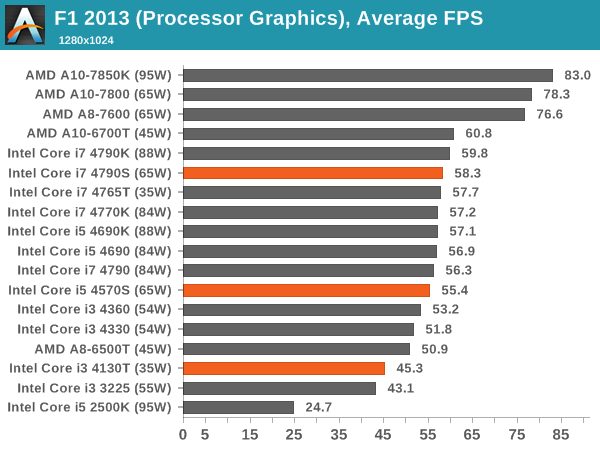

Bioshock Infinite
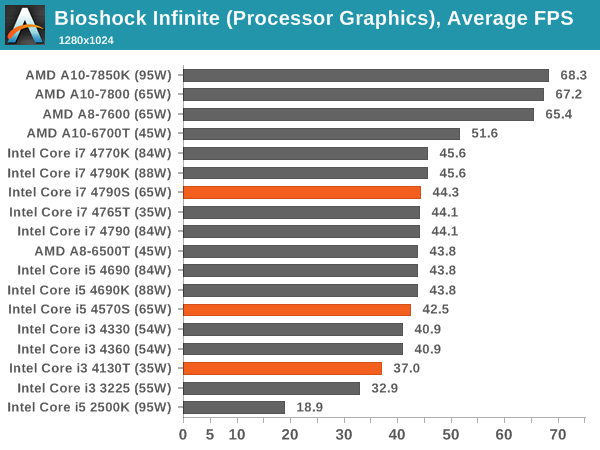
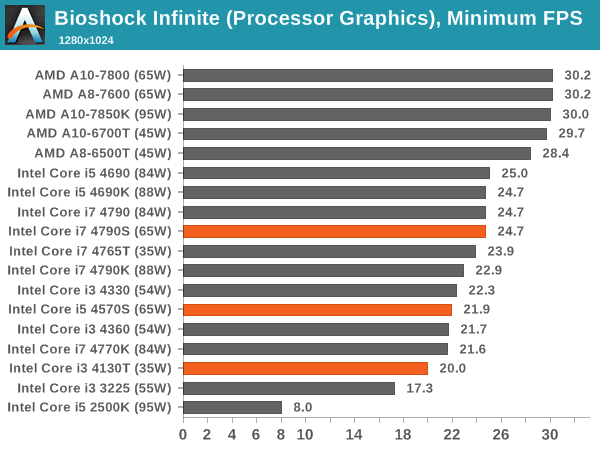
Tomb Raider
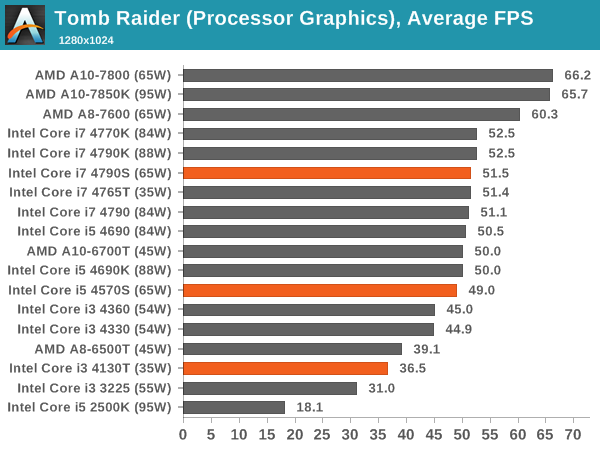
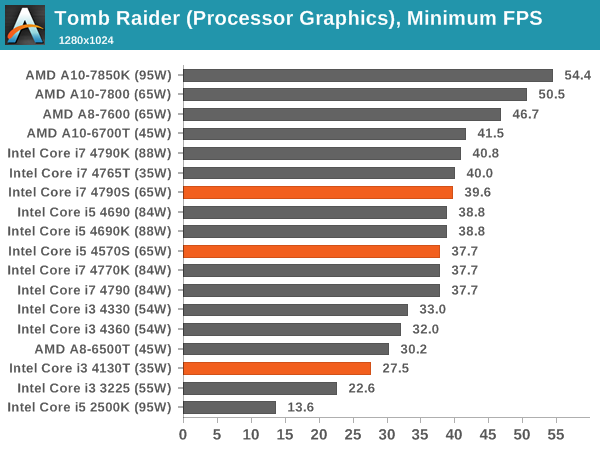
Sleeping Dogs
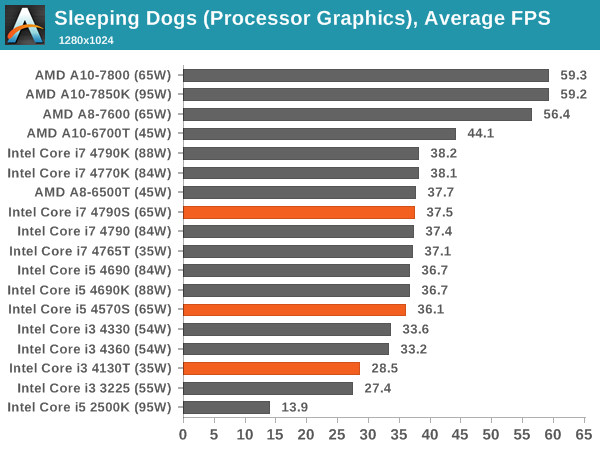
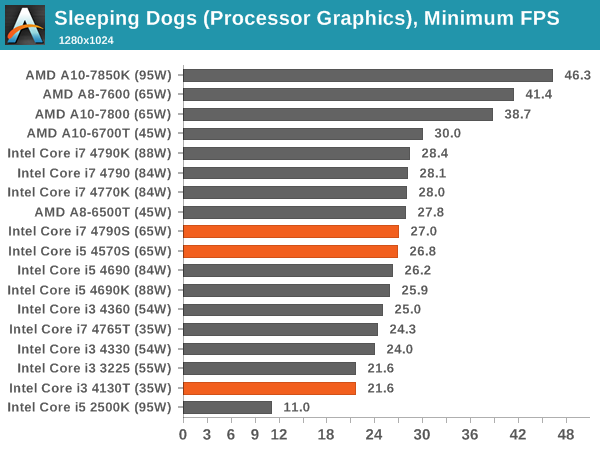
3DMark FireStrike















76 Comments
View All Comments
Gowan08 - Thursday, December 11, 2014 - link
I am happy to see these CPUs doing so well for the price. I used the i5 S for a whitebox esxi server build and I couldn't be happier. I ended up building 2 as a way to get to VSAN in my home. the low power consumption works when you are planning to leave the server running for long periods of time. Rock solid processor.StrangerGuy - Thursday, December 11, 2014 - link
As somebody with a stock 4790K I have completely no idea just *what* exactly is the point of these new chips. It doesn't save any power over regular Haswells with regular consumer workloads when cores simply idle while sacrificing significant performance for insignificant power savings for heavy CPU loads.Daniel Egger - Thursday, December 11, 2014 - link
That's interesting, the numbers tell exactly the opposite and many people would argue the other way round that the little bit extra in performance for special cases (SLI setups, HPC, ...) is not worth the additional energy use at idle and load and even less the additional noise for the more capable cooling system.Peter Cordes - Friday, March 27, 2015 - link
They all use the same power at idle. The lower TDP processors make it safe to use a weaker fan or put them somewhere with worse airflow, even in the worst case when something does load the CPU for an extended duration.This and the xbitlabs article someone else linked show that the low-power variants behave the same as the regular versions, except for throttling down out of turbo sooner or farther under extended load. They are NOT more energy efficient, either in the CPU or the IGP.
HPC is the use-case where these lower TDP chips are exactly the opposite of what you want, unless you're really constrained by cooling, or your workload is actually constrained by memory latency but your CPUs are ramping up to max speed anyway.
Cerb - Sunday, December 14, 2014 - link
It does indeed save power, and the review shows exactly that. That is in fact the entire point. 84W may be too high for some scenarios, so there is a demand for CPUs with lower TDP. The Lenovo Outlet has several such PCs for sale at this very moment, that aren't much bigger than my unmanaged switch. I doubt an i7-4790K could be quietly cooled in such a small enclosure.bsim500 - Thursday, December 11, 2014 - link
These reviews are getting worse...1. I agree with the others. Please include separate idle & load power consumption. Include delta if you want *in addition* to not instead of.
2. Why on Earth would you attempt to review low-power CPU's on a 1250w PSU? This is a large part of the reason why there's only a 2w apparent difference between a 35w "T" and a 53w regular Pentium / i3 - at sub 5% loads the "+90% efficiency at 20-80% load" curve rapidly falls away to as low as 70%, even 60% on some PSU's. It can also add up to 20w to idle consumption which defeats the whole point of a low powered chip. The 35w "T" chips in particular are often used in slim TDP limited cases like the Akasa Euler (typically fed from an external 80-160w "brick" Pico-PSU / SFX PSU's or at most 360-400w Gold ATX (where a 70-80w load would be within the 20-80% load "90% efficiency sweet spot" of Gold PSU's)).
3. Idle to load delta power consumption (with no actual idle / load figures) is even worse than "delta only temps" and results in totally useless figures up to 20w out of whack for intended market (thin Mini-ITX) when it comes from a <5% load on a 1250w PSU that no-one would use on such chips. Again - PLEASE just show idle & load watts / temps in future.
4. The i3-4130T has been replaced (at same price) by the i3-4160T which is 200Mhz faster.
5. Is the Haswell +0.1v auto-overvolt on AVX Prime power virus load test really suitable for load testing on low-power CPU's which more than likely won't be fully loaded (or running constant load AVX apps)?
wintermute000 - Thursday, December 11, 2014 - link
"Why on Earth would you attempt to review low-power CPU's on a 1250w PSU?"THIS
BrokenCrayons - Friday, December 12, 2014 - link
I can kind of understand the PSU wattage. The same PSU has to be used across a lot of different system configurations ranging from very low demand hardware to extremely powerful, multi-GPU builds otherwise the results across the entire range become incomparable and possibly less valuable to readers. Then again, it has been a frequently mentioned sticky point for readers. Maybe branching out to a couple of PSUs that are of slightly more suitable wattage for their application would be useful. I think a lot of Anandtech readers, while very interested in tech reviews, aren't always looking for the very fastest and most powerful hardware available. The site does a really good job catering to that audience (I think so anyhow since sort of consider myself one of those kinds of readers who wants elegant, practical computing solutions instead of the biggest/fastest at any cost) with the exception of the PSU sizing problem you mentioned and the lack of absolute consumption numbers. But still, go easy on them. They have a lot of work to keep them busy and a lot of feedback to consider that might sometimes get conflicted between reader opinions.MrSpadge - Thursday, December 11, 2014 - link
The moderate binning should not require different CPUs. It would be nice if Intel simply used the already established tool of cTDP to offer users a choice. Run normally during winter and switch to power reduced mode in summer, or when a long video transcode is needed. Provide a simple app or windows switch for this. The Win Vista/7 gadgets would be ideal for this. Oh, and this software could be used on notebooks & tablets too, where it would be far more useful.Winterblade - Thursday, December 11, 2014 - link
This was just what I needed to read to convince myself of buying the Alienware Alpha base model :)